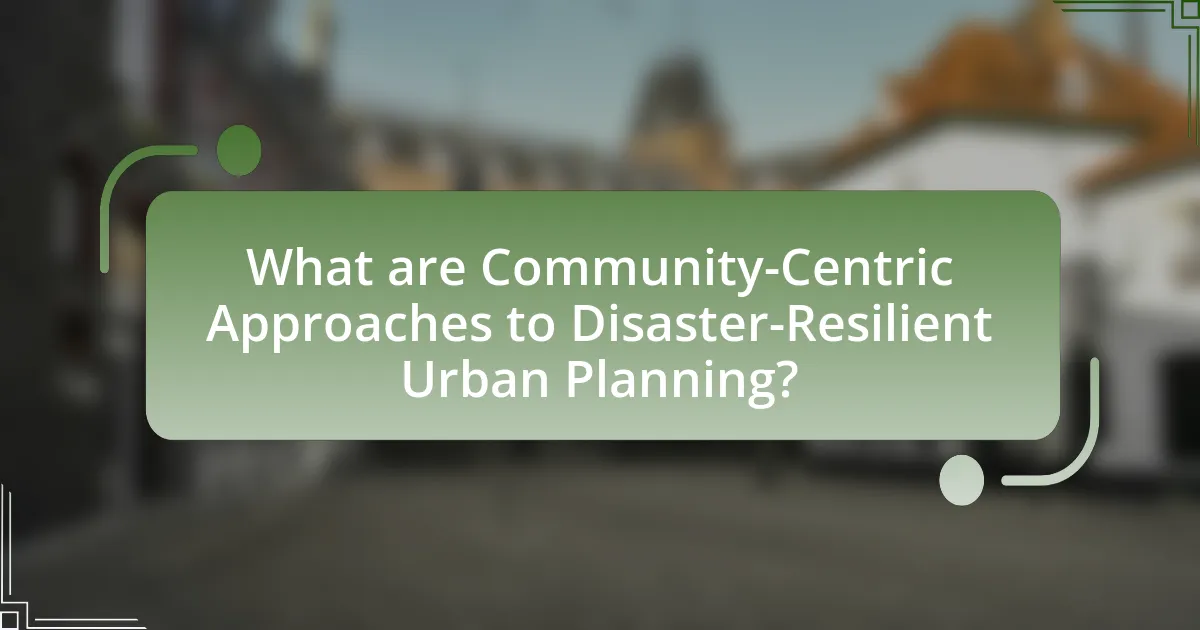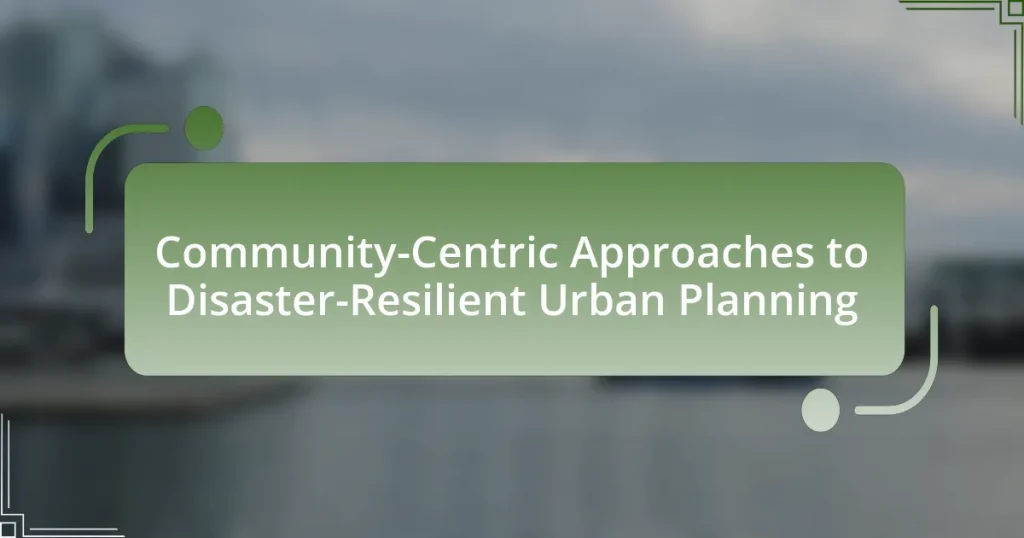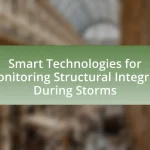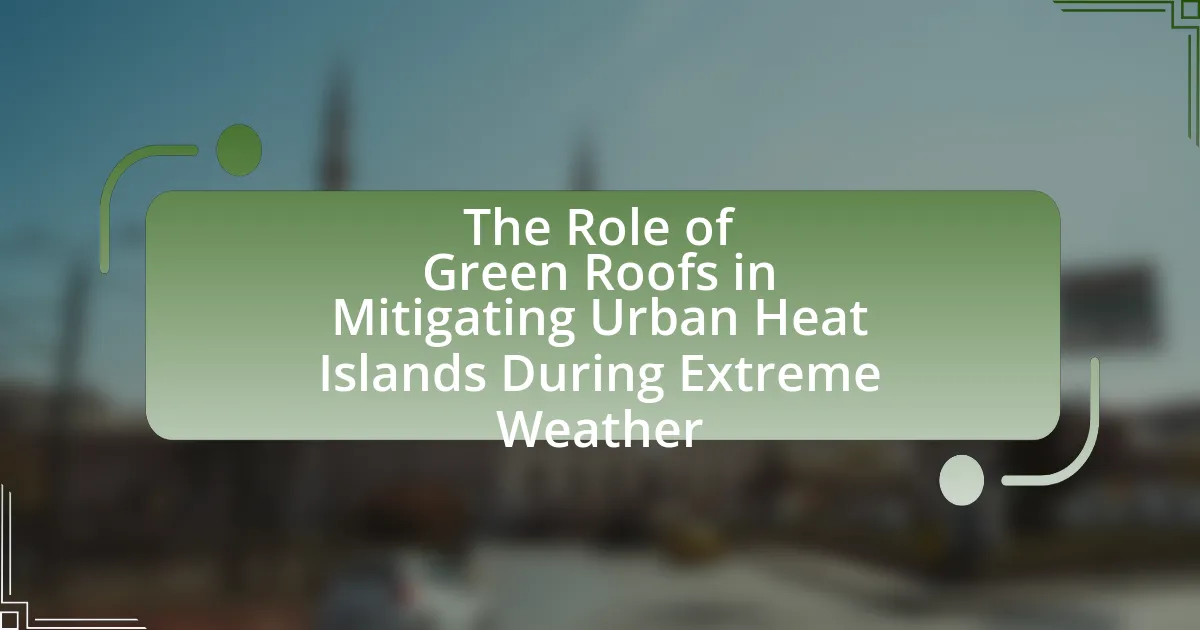Community-centric approaches to disaster-resilient urban planning focus on involving local communities in the planning process to enhance resilience against disasters. These methods prioritize collaboration among government agencies, community organizations, and residents, ensuring that urban planning reflects the unique needs and vulnerabilities of each community. Key principles include inclusivity, empowerment, collaboration, and sustainability, which collectively contribute to more effective disaster preparedness and response. The article explores how community engagement influences urban planning decisions, the importance of disaster resilience, and the role of technology and data analytics in supporting these approaches. Additionally, it addresses challenges in implementation and highlights best practices for fostering collaboration and enhancing community resilience.

What are Community-Centric Approaches to Disaster-Resilient Urban Planning?
Community-centric approaches to disaster-resilient urban planning prioritize the involvement and needs of local communities in the planning process to enhance resilience against disasters. These approaches emphasize collaboration between government agencies, community organizations, and residents to identify vulnerabilities, develop tailored strategies, and implement solutions that reflect the unique characteristics and needs of the community. For instance, research by the United Nations Office for Disaster Risk Reduction highlights that community engagement leads to more effective disaster preparedness and response, as local knowledge and resources are leveraged to create sustainable urban environments.
How do these approaches differ from traditional urban planning methods?
Community-centric approaches to disaster-resilient urban planning differ from traditional urban planning methods by prioritizing local community involvement and resilience over top-down decision-making. Traditional urban planning often relies on expert-driven models that may overlook the specific needs and knowledge of local populations, whereas community-centric methods actively engage residents in the planning process, ensuring that their insights and experiences shape the development of urban spaces. This shift is supported by evidence showing that communities that participate in planning are better equipped to respond to disasters, as they have a deeper understanding of local vulnerabilities and resources, leading to more effective and tailored disaster preparedness strategies.
What principles underpin community-centric approaches?
Community-centric approaches are underpinned by principles such as inclusivity, empowerment, collaboration, and sustainability. Inclusivity ensures that all community members, especially marginalized groups, have a voice in decision-making processes, fostering a sense of belonging and ownership. Empowerment focuses on building local capacities and skills, enabling communities to take charge of their own development and resilience strategies. Collaboration emphasizes partnerships among various stakeholders, including government, non-profits, and community members, to leverage resources and knowledge effectively. Sustainability promotes long-term solutions that consider environmental, social, and economic factors, ensuring that community needs are met without compromising future generations’ ability to meet their own needs. These principles are essential for creating resilient urban environments that can effectively respond to disasters.
How do community needs influence urban planning decisions?
Community needs significantly influence urban planning decisions by guiding the allocation of resources and shaping the design of public spaces. Urban planners often conduct surveys and community engagement sessions to identify specific needs, such as affordable housing, transportation access, and recreational areas. For instance, a study by the American Planning Association found that communities with active participation in planning processes are more likely to have developments that reflect their priorities, leading to increased satisfaction and better utilization of urban spaces. This alignment between community needs and urban planning not only enhances livability but also fosters resilience in the face of disasters, as tailored infrastructure can better withstand and respond to local challenges.
Why is disaster resilience important in urban planning?
Disaster resilience is crucial in urban planning because it enhances a city’s ability to withstand, respond to, and recover from disasters. Effective urban planning incorporates resilience strategies that minimize risks associated with natural hazards, thereby protecting lives and property. For instance, cities that implement resilient infrastructure, such as flood defenses and earthquake-resistant buildings, significantly reduce the economic impact of disasters. According to the United Nations Office for Disaster Risk Reduction, investing in disaster resilience can save up to $7 for every $1 spent on preparedness, highlighting the economic benefits of integrating resilience into urban planning.
What are the key factors contributing to urban vulnerability?
Key factors contributing to urban vulnerability include socioeconomic disparities, inadequate infrastructure, environmental degradation, and lack of effective governance. Socioeconomic disparities, such as poverty and inequality, limit access to resources and services, making certain populations more susceptible to disasters. Inadequate infrastructure, including poorly maintained roads and insufficient drainage systems, exacerbates the impact of hazards like flooding. Environmental degradation, driven by urbanization and climate change, increases the frequency and severity of natural disasters. Lastly, lack of effective governance, characterized by poor planning and insufficient community engagement, hinders the implementation of disaster risk reduction strategies. These factors collectively heighten the vulnerability of urban areas to various hazards.
How can community engagement enhance disaster resilience?
Community engagement enhances disaster resilience by fostering collaboration, improving communication, and building trust among community members and local authorities. Engaged communities are better equipped to identify risks, develop tailored preparedness plans, and mobilize resources effectively during disasters. Research indicates that communities with active participation in disaster planning experience a 30% reduction in response time during emergencies, as noted in the study “Community Engagement in Disaster Risk Reduction” by the United Nations Office for Disaster Risk Reduction. This active involvement leads to more effective recovery efforts and a stronger overall capacity to withstand future disasters.
What role do local communities play in disaster-resilient urban planning?
Local communities play a crucial role in disaster-resilient urban planning by providing localized knowledge and fostering collaboration among stakeholders. Their insights into specific vulnerabilities and resources enable planners to create tailored strategies that address unique community needs. For instance, studies have shown that community engagement in planning processes leads to more effective disaster response and recovery efforts, as seen in the case of New Orleans post-Hurricane Katrina, where local input significantly shaped rebuilding initiatives. This active participation not only enhances the relevance of urban planning but also builds social cohesion, which is essential for resilience during disasters.
How can community participation be effectively facilitated?
Community participation can be effectively facilitated through inclusive engagement strategies that prioritize communication and collaboration. Establishing clear channels for dialogue, such as community meetings and online platforms, allows residents to voice their concerns and contribute ideas. Research indicates that when communities are actively involved in decision-making processes, such as those outlined in the “Community-Centric Approaches to Disaster-Resilient Urban Planning” framework, the outcomes are more sustainable and reflective of local needs. For example, a study by the National Institute of Building Sciences found that projects with strong community involvement are 30% more likely to succeed in achieving their goals.
What are the benefits of involving local stakeholders in planning processes?
Involving local stakeholders in planning processes enhances community engagement, improves decision-making, and fosters trust. Engaged stakeholders provide valuable insights and local knowledge that can lead to more effective and relevant planning outcomes. Research indicates that projects with stakeholder involvement are 30% more likely to succeed, as they align better with community needs and priorities. Additionally, involving local stakeholders can lead to increased transparency and accountability, which are crucial for building trust within the community. This collaborative approach not only strengthens community ties but also ensures that planning processes are more inclusive and equitable.
How can technology support community-centric disaster resilience?
Technology can support community-centric disaster resilience by enhancing communication, improving data collection, and facilitating resource management. For instance, mobile applications enable real-time information sharing among community members during disasters, which can significantly improve response times and coordination. Additionally, Geographic Information Systems (GIS) allow communities to analyze risk factors and plan for potential hazards, leading to more informed decision-making. Research from the National Institute of Standards and Technology indicates that communities utilizing technology for disaster preparedness can reduce recovery times by up to 30%. This demonstrates that integrating technology into community disaster resilience strategies not only empowers residents but also enhances overall safety and preparedness.
What tools and platforms are available for community engagement?
Tools and platforms available for community engagement include social media platforms, community forums, and dedicated engagement software. Social media platforms like Facebook and Twitter facilitate real-time communication and outreach, allowing communities to share information and gather feedback quickly. Community forums, such as Nextdoor, provide localized spaces for residents to discuss issues and collaborate on solutions. Dedicated engagement software, like CitizenLab and Bang the Table, offers structured tools for surveys, polls, and discussions, enabling municipalities and organizations to gather input effectively. These tools enhance participation and ensure diverse voices are heard in urban planning processes, contributing to disaster resilience.
How can data analytics improve urban planning outcomes?
Data analytics can significantly improve urban planning outcomes by providing data-driven insights that enhance decision-making processes. By analyzing demographic trends, traffic patterns, and environmental data, urban planners can identify areas of need, optimize resource allocation, and design infrastructure that meets community demands. For instance, a study by the Urban Institute found that cities utilizing data analytics for planning saw a 20% increase in project efficiency and a 15% reduction in costs. This demonstrates that leveraging data analytics not only streamlines urban planning but also leads to more effective and sustainable community development.
What are the challenges faced in implementing community-centric approaches?
Implementing community-centric approaches faces several challenges, including lack of stakeholder engagement, insufficient funding, and varying community needs. Stakeholder engagement is crucial; without it, initiatives may not reflect the community’s priorities, leading to resistance or failure. Funding is often limited, hindering the ability to sustain programs and initiatives. Additionally, diverse community needs can complicate the development of a unified approach, as different groups may have conflicting interests or priorities. These challenges are documented in studies such as “Community Engagement in Disaster Risk Reduction” by the United Nations Office for Disaster Risk Reduction, which highlights the importance of inclusive participation and resource allocation in successful community-centric strategies.
How can resistance from stakeholders be addressed?
Resistance from stakeholders can be addressed through effective communication and engagement strategies. Engaging stakeholders early in the planning process fosters collaboration and builds trust, which can mitigate resistance. Research indicates that involving stakeholders in decision-making leads to higher acceptance rates; for instance, a study by the International Journal of Project Management found that projects with stakeholder involvement had a 30% higher success rate. Additionally, providing clear information about the benefits of disaster-resilient urban planning can help stakeholders understand the long-term advantages, further reducing resistance.
What are common misconceptions about community involvement?
Common misconceptions about community involvement include the belief that it is solely the responsibility of local government or organizations, and that it requires significant time and resources from individuals. Many people think that community involvement is only about volunteering for large events or projects, overlooking smaller, everyday actions that contribute to community well-being. Additionally, there is a misconception that only certain demographics can effectively participate, which ignores the diverse perspectives and contributions that all community members can offer. Research indicates that inclusive community engagement leads to more effective disaster resilience strategies, as seen in studies by the National Institute of Building Sciences, which highlight the importance of diverse community input in urban planning processes.
What best practices can be adopted for effective community-centric urban planning?
Effective community-centric urban planning can be achieved by actively involving residents in the decision-making process. This participatory approach ensures that the needs and preferences of the community are prioritized, leading to more relevant and sustainable urban designs. Research indicates that cities employing community engagement strategies, such as workshops and surveys, experience higher satisfaction rates among residents and improved project outcomes. For instance, the City of Portland’s Neighborhood Planning Program has successfully integrated community feedback into urban development, resulting in projects that reflect local values and enhance resilience against disasters.
How can successful case studies inform future planning efforts?
Successful case studies can inform future planning efforts by providing evidence-based insights into effective strategies and practices. These case studies highlight successful interventions, allowing planners to analyze what worked, why it worked, and the context in which it was implemented. For instance, the case study of the post-Hurricane Sandy recovery in New York City demonstrated the importance of community engagement in rebuilding efforts, leading to the development of more resilient infrastructure. This evidence supports the notion that incorporating community input can enhance the effectiveness of urban planning initiatives. Additionally, successful case studies often include metrics and outcomes that can serve as benchmarks for future projects, enabling planners to set realistic goals and measure progress effectively.
What strategies can enhance collaboration among community members?
Strategies that can enhance collaboration among community members include establishing clear communication channels, fostering inclusive participation, and creating shared goals. Clear communication channels, such as community meetings and digital platforms, facilitate information exchange and ensure that all voices are heard. Fostering inclusive participation encourages diverse community members to engage, which can lead to more innovative solutions and a stronger sense of ownership. Creating shared goals aligns community efforts and resources, promoting teamwork and collective action. Research indicates that communities with strong collaborative frameworks are better equipped to respond to disasters, as evidenced by the success of community-led initiatives in various urban planning projects.
What practical steps can communities take to promote disaster resilience?
Communities can promote disaster resilience by implementing comprehensive preparedness plans, enhancing infrastructure, and fostering community engagement. Preparedness plans should include regular training exercises and clear communication strategies to ensure all residents understand emergency procedures. Infrastructure improvements, such as retrofitting buildings to withstand earthquakes or floods, significantly reduce vulnerability; for instance, cities like San Francisco have invested in seismic upgrades to critical facilities. Community engagement through workshops and local drills builds social cohesion and ensures that residents are actively involved in resilience efforts, as evidenced by the success of programs in New Orleans post-Hurricane Katrina, which emphasized local participation in recovery planning.




